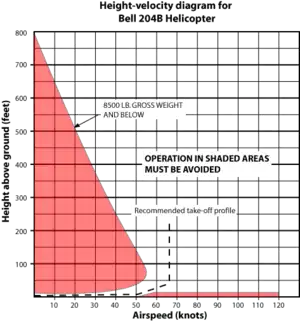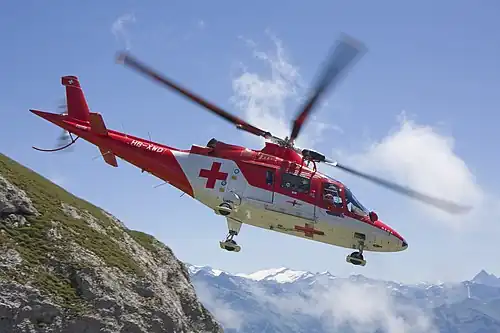The FAA states "The height–velocity diagram or H/V curve is a graph charting the safe/unsafe flight profiles relevant to a specific helicopter. As operation outside the safe area of the chart can be fatal in the event of a power or transmission failure it is sometimes referred to as the dead man's curve."[1] The EASA refers to it as the "height/velocity avoid curve".[2]
The H–V curve is a diagram indicating the combinations of height above ground and airspeed that should be avoided due to safety concerns relating to emergency landings. It is dangerous to operate within the shaded regions of the diagram, because it may be impossible for the pilot to complete an emergency autorotation from a starting point within these regions.[3] The H–V curve also contains a take-off profile, indicating how a pilot can start from 0 height and 0 speed, and safely traverse to cruise. At low heights with low airspeed, such as a hover taxi, the pilot can simply cushion the landing with collective by converting rotational inertia into lift. Conversely, a complete power loss, and resultant crash landing, from a three-foot hover taxi at walking pace may be survivable. Multi-engine helicopters capable of flying and hovering on a single engine, don't depict this second region.[1]
As the airspeed increases without an increase in height, there comes a point where the pilot's reaction time would be insufficient to initiate a flare, and prevent a high-speed ground impact. Each increase in height increases the pilot reaction time. This is the reason the bottom right part of the H–V curve has a shallow gradient. If above ideal autorotation speed, a pilot can avoid the deadman's curve by flaring, converting airspeed into height, and increasing rotor RPM through coning.[4][1]
Likewise, an increase in height without a corresponding increase in airspeed is dangerous, as a crash from this height may not be survivable. Airspeed has to increase beyond the 40–80 knot range, allowing the safe initiation of an autorotation. Thus a safe take-off profile, initiating forward flight from a low hover, involves gaining height as airspeed approaches a safe autorotation speed.[1]
See also
References
- 1 2 3 4 5 Helicopter Flying Handbook, FAA-H-8083-21A (PDF). U.S. Dept. of Transportation, FAA, Flight Standards Service. 2012. pp. 11-8–11-12, 11-17–11-20.
- ↑ Helicopter Airmanship Training Leaflet HE2 (PDF). European Helicopter Safety Team. 2011. p. 15. Retrieved 19 October 2020.
- ↑ Leishman, J. Gordon (2006). Principles of Helicopter Aerodynamics. New York: Cambridge University Press. pp. 249–250. ISBN 978-0-521-85860-1.
- ↑ Chapter 11: Helicopter Emergencies and Hazards. 6 MB page 11-8. Main page. Rotorcraft Flying Handbook, FAA Manual H-8083-21A. Complete manual, 84 MB, Washington, DC: Flight Standards Service, Federal Aviation Administration, U.S. Dept. of Transportation, 2012.

